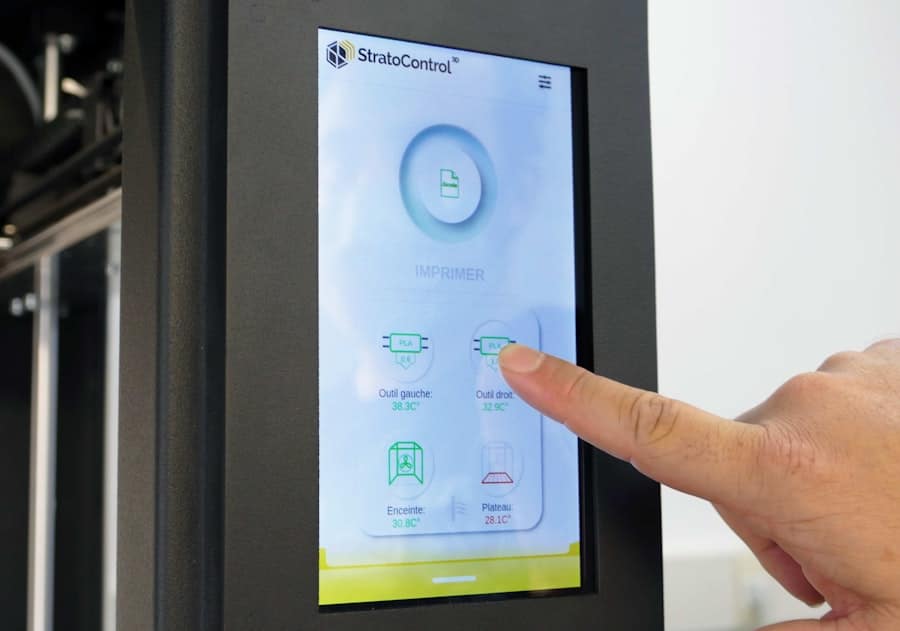Biometric technology refers to the measurement and statistical analysis of people’s unique physical and behavioral characteristics. This technology has gained significant traction in various sectors, particularly in security and identification systems. By leveraging unique traits such as fingerprints, facial recognition, iris patterns, and voice recognition, biometric systems provide a more secure and efficient means of verifying identity compared to traditional methods like passwords or PINs.
The rise of digital banking has further accelerated the adoption of biometric technology, as financial institutions seek to enhance security measures while improving user experience. The evolution of biometric technology can be traced back to the early 20th century when fingerprinting was first used for criminal identification. Over the decades, advancements in technology have led to the development of sophisticated biometric systems that can analyze a wide range of human characteristics.
Today, biometric technology is not only used in law enforcement but has also permeated everyday life, from unlocking smartphones to accessing secure facilities. In the context of digital banking, the integration of biometric technology represents a paradigm shift in how financial institutions approach security and customer authentication.
Key Takeaways
- Biometric technology uses unique physical or behavioral characteristics for identification and authentication purposes.
- Biometric technology plays a crucial role in enhancing digital banking security by providing a more secure and convenient authentication process.
- The advantages of biometric technology in digital banking include increased security, reduced fraud, and improved customer experience.
- Types of biometric technology used in digital banking include fingerprint recognition, facial recognition, iris scanning, voice recognition, and behavioral biometrics.
- Challenges and limitations of biometric technology in digital banking include privacy concerns, potential security vulnerabilities, and the need for continuous technological advancements to stay ahead of fraudsters.
- The implementation of biometric technology in digital banking involves integrating biometric authentication methods into existing banking systems and ensuring compliance with regulatory requirements.
- Future trends in biometric technology for digital banking security may include the use of advanced biometric modalities, such as vein pattern recognition and DNA biometrics, as well as the integration of biometrics with other emerging technologies like artificial intelligence and blockchain.
- In conclusion, biometric technology has a significant impact on digital banking security, offering a more secure and user-friendly authentication process while also presenting challenges that need to be addressed for its continued success.
The Role of Biometric Technology in Digital Banking Security
Enhanced Security through Biometric Technology
Biometric technology plays a crucial role in this landscape by providing a robust layer of security that is difficult to replicate or forge. Unlike traditional authentication methods that rely on something the user knows (like a password) or possesses (like a bank card), biometrics are inherently tied to the individual, making unauthorized access significantly more challenging.
Streamlined User Experience
For instance, many banks have begun implementing fingerprint scanning and facial recognition as part of their mobile banking applications. These technologies not only enhance security but also streamline the user experience by allowing customers to access their accounts quickly and conveniently.
Reducing Fraud and Identity Theft
The integration of biometric authentication reduces the likelihood of fraud and identity theft, as it is nearly impossible for an imposter to replicate an individual’s unique biological traits. As a result, biometric technology has become an essential component of digital banking security strategies.
Advantages of Biometric Technology in Digital Banking

The advantages of biometric technology in digital banking extend beyond enhanced security. One of the most significant benefits is the improved user experience it offers. Customers often find traditional authentication methods cumbersome and frustrating, especially when they forget passwords or face issues with two-factor authentication.
Biometric systems eliminate these pain points by allowing users to authenticate their identities with a simple touch or glance, making transactions smoother and more efficient. Moreover, biometric technology can significantly reduce operational costs for banks. By minimizing the reliance on traditional authentication methods, financial institutions can decrease the number of customer service inquiries related to password resets or account lockouts.
This not only saves time for both customers and bank employees but also allows banks to allocate resources more effectively. Additionally, the implementation of biometric systems can enhance customer trust and loyalty, as clients feel more secure knowing that their financial information is protected by advanced technology.
Types of Biometric Technology Used in Digital Banking
Several types of biometric technologies are currently being utilized in digital banking, each with its unique advantages and applications. Fingerprint recognition is one of the most widely adopted forms of biometric authentication. Many smartphones come equipped with fingerprint scanners, allowing users to access their banking apps securely with just a touch.
This method is not only fast but also highly accurate, making it a popular choice among financial institutions. Facial recognition technology has also gained traction in digital banking. By using advanced algorithms to analyze facial features, banks can authenticate users quickly and securely.
This technology is particularly useful for remote transactions, where customers may not have access to physical devices like fingerprint scanners. Additionally, voice recognition is emerging as another viable option for biometric authentication in banking. By analyzing vocal patterns and speech characteristics, banks can offer a hands-free authentication method that enhances accessibility for users with disabilities or those who prefer voice commands.
Challenges and Limitations of Biometric Technology in Digital Banking
Despite its numerous advantages, biometric technology is not without challenges and limitations. One significant concern is privacy. The collection and storage of biometric data raise questions about how this sensitive information is managed and protected.
If a bank’s database were to be compromised, the consequences could be dire, as biometric traits cannot be changed like passwords can. This potential for data breaches necessitates robust security measures to ensure that biometric data is encrypted and stored securely. Another challenge lies in the accuracy and reliability of biometric systems.
While technologies like fingerprint and facial recognition have made significant strides in recent years, they are not infallible. Factors such as lighting conditions, skin conditions, or even aging can affect the performance of these systems. False positives or negatives can lead to frustration for users or even unauthorized access in some cases.
Implementation of Biometric Technology in Digital Banking

Infrastructure Assessment and Upgrade
A thorough evaluation of the existing infrastructure is essential to determine the best approach for integrating biometric systems. This may involve upgrading software and hardware or investing in new technologies that support biometric authentication methods.
Staff Training and Customer Education
Training staff is another critical aspect of successful implementation. Employees must understand how to use biometric systems effectively and be prepared to assist customers who may have questions or concerns about the new technology. Additionally, banks should communicate transparently with their customers about the benefits and security measures associated with biometric authentication.
Building Trust through Transparency
Educating users on how their biometric data will be used and protected can help alleviate concerns about privacy and build trust in the new system. By being open and transparent about the benefits and security measures of biometric authentication, financial institutions can ensure a smooth transition to this new technology.
Future Trends in Biometric Technology for Digital Banking Security
As technology continues to evolve, so too will biometric solutions in digital banking. One emerging trend is the integration of multi-modal biometric systems that combine various forms of authentication for enhanced security. For example, a bank might implement a system that requires both fingerprint scanning and facial recognition for high-value transactions, providing an additional layer of protection against fraud.
Another trend is the use of artificial intelligence (AI) and machine learning algorithms to improve the accuracy and efficiency of biometric systems. These technologies can analyze vast amounts of data to identify patterns and anomalies, allowing banks to detect potential fraud more effectively. Furthermore, advancements in wearable technology may lead to new forms of biometric authentication that leverage physiological data such as heart rate or body temperature.
As customers increasingly demand seamless interactions with their financial institutions, banks will need to prioritize convenience without compromising security. This may involve developing more intuitive interfaces for biometric authentication or exploring innovative solutions like behavioral biometrics that analyze user behavior patterns for identity verification.
The Impact of Biometric Technology on Digital Banking Security
The impact of biometric technology on digital banking security is profound and multifaceted. By providing a secure and efficient means of identity verification, biometrics have transformed how financial institutions approach customer authentication. The advantages—ranging from enhanced security to improved user experience—underscore the importance of integrating this technology into digital banking strategies.
However, challenges such as privacy concerns and system reliability must be addressed to fully realize the potential of biometrics in this sector. As banks continue to innovate and adapt to changing technological landscapes, the future promises exciting developments that will further enhance security measures while prioritizing customer convenience. Ultimately, the ongoing evolution of biometric technology will play a pivotal role in shaping the future of digital banking security, ensuring that customers can engage with their financial institutions confidently and securely.
A related article to How Biometric Technology Is Reshaping Digital Banking Security can be found on TrustedReviews, which provides expert reviews of the latest technology trends in the industry. This article may offer additional insights into the advancements and benefits of biometric technology in digital banking security. To read more about the latest technology trends, visit TrustedReviews.
FAQs
What is biometric technology?
Biometric technology uses unique physical or behavioral characteristics, such as fingerprints, facial recognition, or voice patterns, to verify a person’s identity.
How is biometric technology reshaping digital banking security?
Biometric technology is enhancing digital banking security by providing a more secure and convenient way for customers to authenticate their identity, reducing the risk of fraud and unauthorized access to accounts.
What are the benefits of using biometric technology in digital banking?
Some benefits of using biometric technology in digital banking include increased security, reduced fraud, improved customer experience, and streamlined authentication processes.
What are some common biometric authentication methods used in digital banking?
Common biometric authentication methods used in digital banking include fingerprint scanning, facial recognition, voice recognition, and iris scanning.
Are there any concerns about using biometric technology in digital banking?
Some concerns about using biometric technology in digital banking include privacy issues, potential data breaches, and the need for robust security measures to protect biometric data.
How is biometric technology being integrated into digital banking systems?
Biometric technology is being integrated into digital banking systems through mobile apps, ATMs, and online banking platforms, allowing customers to use their biometric data to securely access their accounts and conduct transactions.

